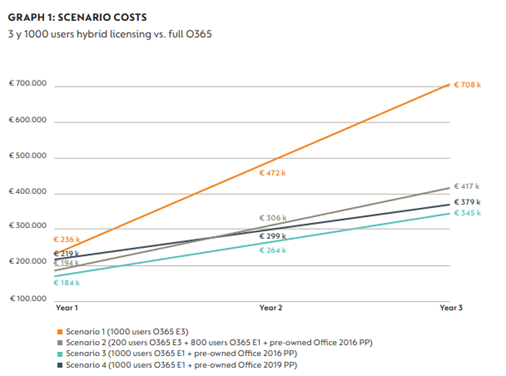How pre-owned software reduces the impact of Microsoft price increases
This article was co-authored with Michael Vilain, Director of International Sales at CapeFoxx AG.
Microsoft price increases
 Microsoft is increasing Office/Microsoft 365 prices in March 2022, with several products seeing double-digit rises:
Microsoft is increasing Office/Microsoft 365 prices in March 2022, with several products seeing double-digit rises:
- Office 365 E1 – 25% up
- Office 365 E3 – 15% up
- Office 365 E5 – 8.6% up
- Microsoft 365 E3 – 12.5% up
There are several options for an asset manager to mitigate this increase and one option is to explore the pre-owned software market – particularly for the Microsoft Office suite.
While the pre-owned option has been around for longer than many are aware, it’s still growing and has plenty to offer for many organisations. There are two ways an organisation can take advantage of the opportunity – as a buyer and/or as a seller.
Buying pre-owned software
The current release of Microsoft Office on-premises is 2021 but the question you need to ask yourself is:
“Do all our users really need it all?”
While a whole range of new features are added with each new release of Microsoft Office, will they be utilised by a significant portion of your user base? If not, why spend money on new features that will sit there unused? Wouldn’t it be more cost effective if you could instead purchase an earlier version with fewer unnecessary features at a lower cost? That’s what pre-owned software enables you to do.
Organisations tend to stay on older versions of Office for 3 reasons:
- They require compatibility with an on-premises LOB (Line of Business) app
- They don’t have the time/budget to re-train users on new features/layouts/interfaces
- They don’t see the value in the new version’s additional features
In all these scenarios, the usual course of action is to purchase new licenses and downgrade them to the earlier version required – however, this means you’re paying for the latest and greatest, whilst not using those new features that you’re paying for. Analyse your users by role to understand who will, and won’t, benefit from the new features in the different releases of Microsoft Office.
Hybrid licensing
This approach doesn’t mean forgoing the benefits of the various Microsoft online services within Office 365. Instead, one can implement a hybrid approach where users are licensed with a combination of Office 365 subscriptions and pre-owned perpetual Office licenses.
There are several possible hybrid combinations available to an organisation, below we see four:

- Office 365 E3
- Office 365 E1 + E3 + pre-owned Office 2016
- Office 365 E1 + pre-owned Office 2019
- Office 365 E1 + pre-owned Office 2016
It may be that you employ a combination of these within your organisation to get the best balance between user requirements and cost optimisation. As with so many aspects of ITAM, a deeper insight into users and their requirements can lead to greater cost savings being uncovered.
The other side of this equation is selling your existing Microsoft software licenses. If your organisation has made the move to the cloud, you may well have legacy Microsoft licenses that you can sell into the burgeoning secondary market. Good news – following a change in June 2021, removing the need to retain on-premises licenses, organisations taking advantage of Microsoft’s “From SA” SKUs for Microsoft 365 are able to resell their licenses.
Following the release of Office 2021, Office 2016 can net an organisation €15 per license while Office 2019 can make you as much as €60. These are ball-park figures and the actual prices can depend on a range of factors.
This can be a fantastic way to make ITAM a profit centre, clearly adding money to the bottom line that can be used to modernise and expand the ITAM team and/or drive forward other areas such as digital transformation projects across the business.
Is it right for me?
According to Capefoxx AG, the most likely sectors to buy pre-owned software include:
- Public Sector
- Healthcare
- Retail
- Manufacturing
but it can be a successful option for organisations in almost any line of business. The main restriction is geographical as there is only legal precedent for this within the European Union (EU) – meaning many organisations around the world may not be able to take full advantage of this. However, even if you’re based outside of Europe, this may be something you can use for your European offices.
As it is based on EU law, those of you in the UK, Norway, and Switzerland must pay special attention to what is possible. While organisations in these countries are (currently) free to purchase pre-owned software, it is not as straight forward when it comes to selling your software. For example, licenses purchased before/after Brexit are treated differently.
Conclusion
The Microsoft price increase in March 2022 represents a clear opportunity to investigate the potential benefits of the pre-owned software market.
- Look at your Microsoft contract and calculate the new total after the price increase. Is there potential to change your licensing strategy to make savings?
- Review your Microsoft purchase history – particularly around version upgrades and cloud migrations -and identify surplus software you may be able to sell.
- Calculate the potential savings/earnings available to you.
- Speak to internal stakeholders, including legal, and understand their position.
- Engage with a pre-owned software specialist like Capefoxx AG to get started
With the pressure to reduce software spend as strong as ever – particularly with the ongoing impact of COVID-19, pre-owned software can offer a new avenue for both savings and growth for your business.
Can’t find what you’re looking for?
More from ITAM News & Analysis
-
Software Vendor Insights: What do the numbers tell us about the opportunities for ITAM negotiations?
What software vendor insights can be gained from the latest financial results from Amazon, Google, Broadcom, Salesforce, IBM and SAP? An important part of ITAM is paying close attention to the health of the companies we ... -
Flexera is first SAM tool vendor verified for Oracle E-Business Suite applications
Flexera has announced that it has been verified as the first software asset management (SAM) tool vendor for Oracle E-Business Suite applications. Almost anyone with an Oracle estate will be familiar with the company’s License Management ... -
ITAMantics - March 2024
Welcome to the March 2024 edition of ITAMantics, where George, Rich and Ryan discuss the month’s ITAM news. Up for discussion this month are. Listen to the full ITAMantics podcast above or queue it up from ...